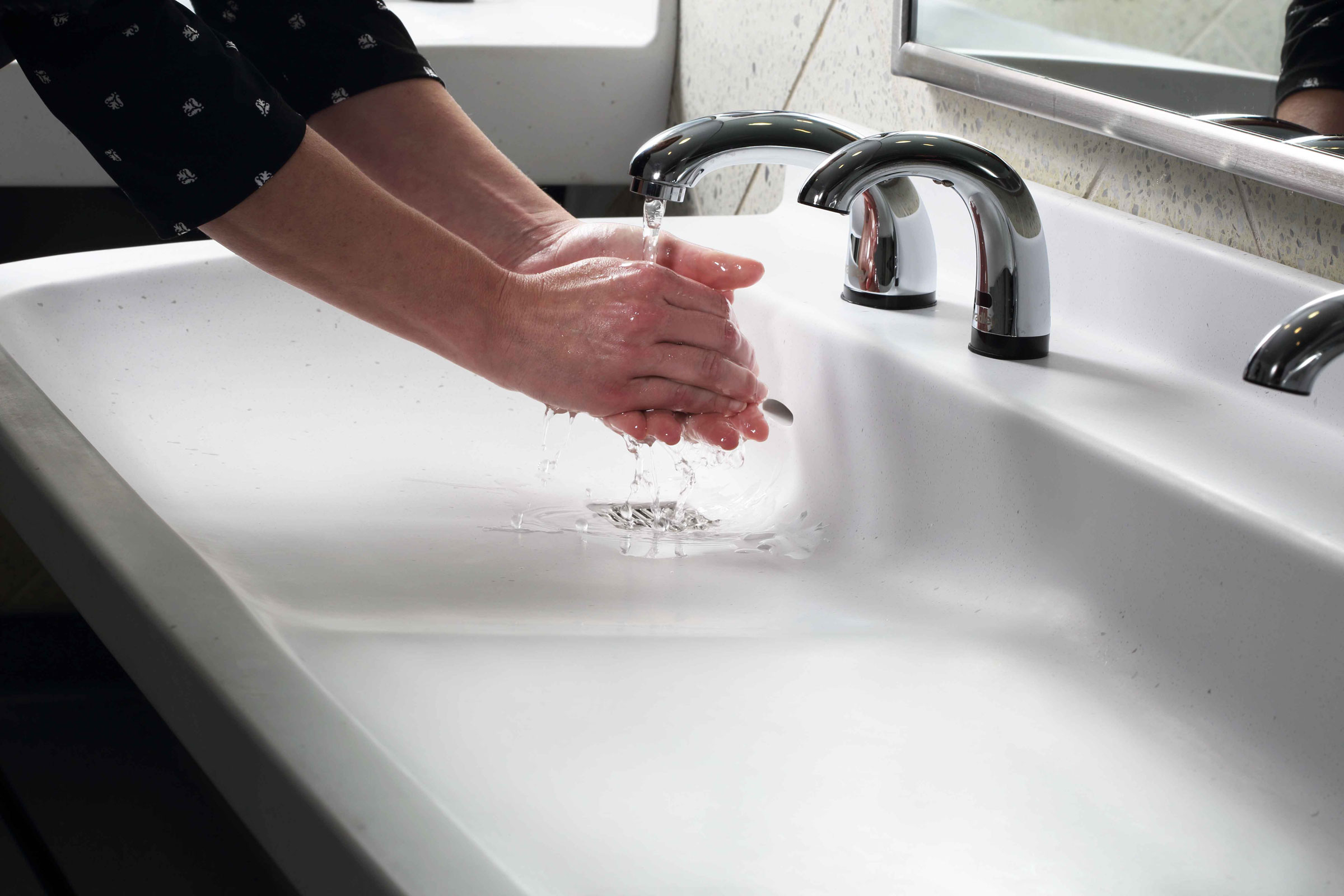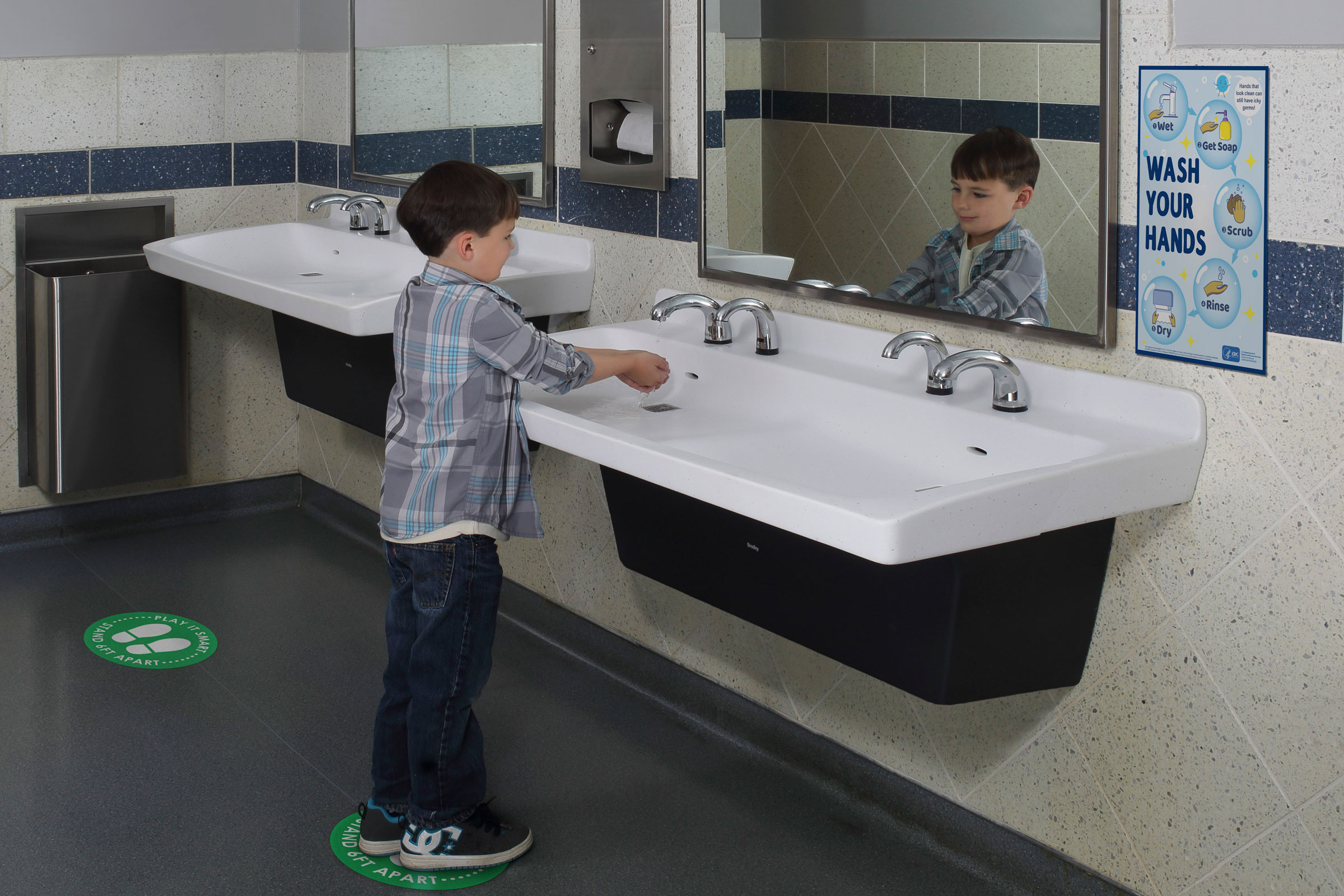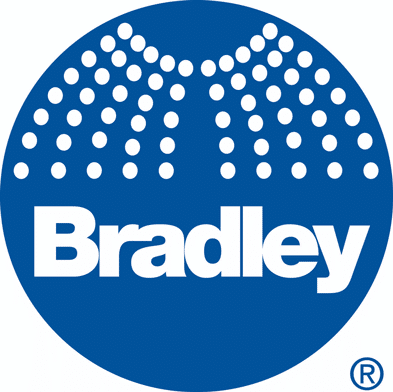Story at a glance:
- In August 2020 Bradley conducted a survey of 1,000 high school students and found that 50% of the students considered their schools’ restrooms to be fair or poor.
- Bradley’s Express Lavatory Systems, including new Express GLX Series and Express TLX Series, made of Terreon® Solid Surface, offer a streamlined trough design that’s touchless and easy to clean.
- Putting sinks at appropriate heights, having deeper sinks that are easy to clean, and ensuring sensors are reliable all encourage handwashing.
We all know public bathrooms could be a nightmare long before COVID-19. And we can all recall times when we were appalled to see someone walk out of a stall and straight into the world—no soap, no water, no handwashing at all. Commercial plumbing equipment manufacturer Bradley Corp. has been studying handwashing habits and trends as part of their research to deliver top solutions in public restrooms, from their Express® lavatory systems to their hand sanitizer dispensers.
These days Bradley is conducting even more studies, focusing in part on high school students’ handwashing behaviors as well as surveying American adults to find out how coronavirus is affecting their handwashing behavior. The company has been conducting handwashing studies for more than 10 years.
In August 2020 Bradley conducted a survey of 1,000 high school students and found that 50% of the students considered their schools’ restrooms to be fair or poor. Nearly 60% reported being nervous about attending school amidst coronavirus, and nearly half said they were worried they wouldn’t have enough time to wash their hands during the school day.
Bradley is trying to make it easier than ever for people to wash and dry hands properly and maintain good hygiene. It goes back to the company’s mission, which began 100 years ago. “We’ve been all about touch-free for years,” says Will Haas, senior product manager at Bradley. “It goes back to our innovations and sensor technology many decades ago.”
Bradley was founded on the hands-free concept, dating back to their first product in 1921—a foot activated water fountain. “The whole concept of touch-free metered water and saving water, that’s not something we started because other companies were starting to go green or because of COVID; we’ve been doing this a very long time,” Haas says.

Bradley’s Express Lavatory Systems like the new Express GLX Series and Express TLX Series has a Terreon Solid Surface for superior durability. Pictured here is Bradley’s Express-ELX Series. Courtesy of Bradley Corp.
In the last decade Bradley has continued to innovate with all-in-one sink systems. Their Express Lavatory Systems, including new Express GLX Series and Express TLX Series, made of Terreon® Solid Surface, offer a streamlined trough design that’s touchless and easy to clean. Bradley’s smart WashBar® is also touchless and houses soap, water, and dryer all in one sleek unit, eliminating the mess of suds, paper towels, and water that often ends up all over the floor.
Haas says products like WashBar change the dynamic of the commercial restroom, and with its LED lights and engaging user icons, kids even get excited to wash their hands. It’s much more interesting than that little faucet at their house, he laughs.
Bradley’s Touchless Verge™ Soap and Faucet Sets also feature patented dual sensor technology and low flow options. Haas says architects love the many styles available, including the Crestt model, with its high arc design and environmentally friendly finishes. Matching soap and faucet designs integrate seamlessly with Bradley lavatories or any handwashing fixture. Haas says those dual sensors are vital as they make the faucets even more efficient in power use, rather than some touchless faucets that have trouble registering users. The dual sensors maximize battery life.
“More than 76% of people we’ve surveyed say they’ve had an unpleasant public bathroom experience, and the numbers are growing every year,” says Jon Dommisse, director of global strategy and corporate development at Bradley, referring back to their many surveys. That can’t be good for business, and Dommisse says it’s not. Nearly 60% of those surveyed say they’re unlikely to return to a place of business if they’ve had a bad bathroom experience there.
Over the years people have started to demand nicer bathrooms in general, and that in turn has impacted hygiene, Haas says. “In the past it was just ‘throw a sink in a space and hope people wash their hands.’ Now encouraging handwashing is very important.” He says things like putting sinks at appropriate heights, having deeper sinks that are easy to clean, and ensuring sensors are reliable are of utmost concern.
Bradley does more than make great sinks, though. They offer virtually everything that touches your washroom experience. “We can help with the holistic design of the washroom, and we can talk about traffic flow,” Dommisse says. He says schools are unique as they have peak times—in between classes—when the bathrooms experience high usage and other times when they go virtually unused. “There can be a lot of congestion, so a lot of our products are designed and calibrated for expediting the traffic flow through a public bathroom.”
Bradley is a big supplier of high-end, easy-to-use, sustainable solutions in schools in part because they’re also affordable and durable. Dommisse says Bradley focuses on the overall life cycle cost over the life of a product, considering schools often don’t have many maintenance people or immense budgets; they need products that are built to last. “They really look to Bradley to have products that are durable, very reliable, easy to clean, and easy to repair from a parts standpoint.”
The team at Bradley has spent a lot of time talking with architects, engineers, interior designers, and building owners, and Dommisse says all seem to agree: There is no clear indication for what future public bathrooms will look like. Experimentation is widespread, from floor plans to products. “9/11 changed travel on planes, and I think COVID will forever change public bathroom design,” he says. “There will be some permanent, significant changes. I don’t think people are going to feel comfortable touching multiple things in a public bathroom again.”
Haas agrees. “The design trend overall in restrooms is going to work to eliminate every single touchpoint possible. That’s top of mind for designers.



